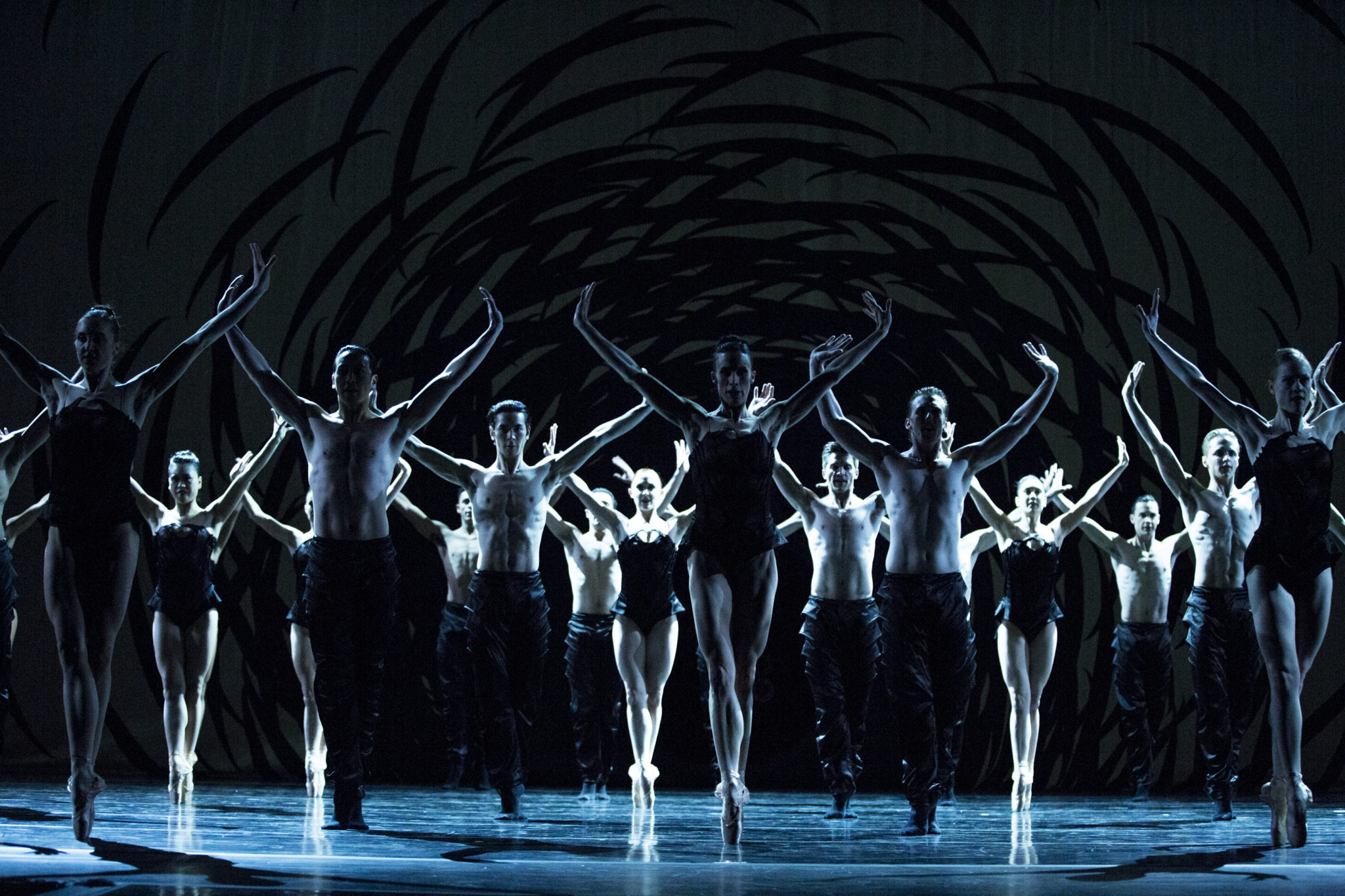Emergence, the ballet by Crystal Pite that lends its name to the mixed rep program wrapping up at Pacific Northwest Ballet this weekend, is one of my favorite ballets of all time. Like everyone else who saw its premiere at PNB in 2013, I fell in love with immediately. I was surprised when I rewatched it last weekend that it seemed almost completely different from what I remembered. But I still loved every minute of it.
Old Ideas
When I watched Emergence the first time, the dark visual aesthetic and Owen Belton’s electro-industrial soundtrack placed this piece next to Turandot on my mental shelf of “fine art for metalheads.” The vaguely uneasy atmosphere; the uncanny, bug-like movements; the ominous uniformity of the dancers counting and marching. All of these things delighted my inner goth.
There seemed to be a metaphor that both expressed artists’ fear of creativity-blocking conformity and reduced the unthinking masses to bugs. The pulsing patterns of individuals and the flow of groups across the stage evoked insect swarms. It was both fascinating and repulsive – like a horror movie – but somehow still as elegant and beautiful as ballet.

Pacific Northwest Ballet company dancers in Crystal Pite’s Emergence, which PNB is presenting as part of a mixed rep with two other works, April 13 – 22, 2018. Photo © Angela Sterling.
New Impressions
This time around, the entire piece felt lighter. I was better able to recognize the more traditional ballet elements, and even some of the twitchy bug-like movements seemed more elegant and graceful. The repeating patterns of the music were reassuring.
I noticed the effect of (literal) light more than darkness, and the way the cast shadows created a sense of a warm, enclosed space. I had forgotten how the piece begins – a creature hatches from an egg with the unsteady, half-formed movement of all newborns. A second dancer supports and guides it until it masters movement. Even in the soulless hive, there is support for the weakest members.
This time, instead of seeing the male and female dancers squaring off against each other, I saw different species of bugs protecting their own kind. The counting didn’t feel like it was enforcing lockstep conformity. This time it felt like a reminder that order requires constant maintenance, and that every individual contributes to the whole.
I got the feeling that Crystal Pite likes bugs. The hive didn’t seem like such a bad place at all.
I think there were two things that made Emergence feel so different this time around – context, and the book.
Context
Emergence was the third ballet in the program, following Little mortal jump and RakU. Little mortal jump was a powerful emotional experience that leaves the viewer feeling inexplicably bereft. RakU is a tremendously uncomfortable exploration of what happens when an individual gives way to the impulses that destroy the social fabric – and the individuals within it. By contrast, the order and harmony of Emergence is consoling rather than stifling.
By the Book
I don’t know how I missed it the first time, but Emergence is based on a book. I know a lot of ballets are rooted in literature, but usually they are stories that have entered the common culture and been rewritten and adapted many times in multiple formats. This ballet is based on the book Emergence: The Connected Lives of Ants, Brains, Cities and Software, by Steven Johnson. Be still my heart. A ballet based on a science book! You can bet I’ve got a hold on that one at the library. (I’m fifth in line for a nonfiction book that published in 2001. Looks like I’m not the only local ballet fan with a library card.)
Anyway, I haven’t read the book yet, and I’m not familiar with emergence theory. But just reading about it in the program booklet was enough to alert me to the significance of opening the ballet with an individual emerging from its egg. It also clued me in to the idea that:
simple agents following simple rules could generate amazingly complex structures
That made me hear the music and watch the movement with more of an eye to patterns. Thinking in terms of building blocks and collective construction went a long way in transforming Emergence from a thrilling horror movie to hopeful meditation on social structure and creativity.
Now that I’ve seen Emergence in two completely different ways, I love them both.
Tickets
It’s not too late to see Emergence, but there aren’t many chances left. The remaining performances are:
April 20–21 at 7:30 pm
April 22 at 1:00 pm
Tickets ($37-$187) may be purchased online. Subject to availability, tickets are also available 90 minutes prior to each performance at McCaw Hall – these tickets are half-price for students and seniors; $5 for TeenTix members.
Just the Facts
Crystal Pite’s Emergence
Music: Owen Belton (2009)
Choreography: Crystal Pite
Staging: Hope Muir
Scenic Design: Jay Gower Taylor
Costume Design: Linda Chow
Lighting Design: Alan Brodie
Duration: 28 minutes
Premiere: March 4, 2009; National Ballet of Canada (Toronto)
Pacific Northwest Ballet Premiere: November 8, 2013
Cast I saw:
Prologue
Rachel Foster
Joshua Grant
Grand Pas
Lindsi Dec
Karel Cruz
Trio
Emma Love Suddarth
Sarah Pasch
Elle Macy
Sextet
Benjamin Griffiths
Kyle Davis
Steven Loch
Dylan Wald
Price Suddarth
Ezra Thomson
Bee Man
Price Suddarth
Quartet
Leah Merchant
Steven Loch
Benjamin Griffiths
Ezra Thomson





About the author